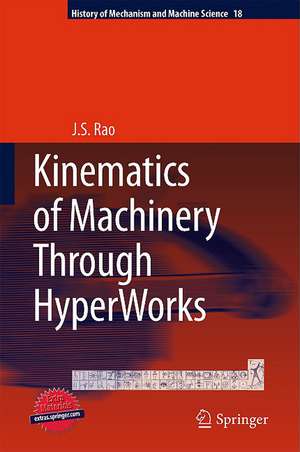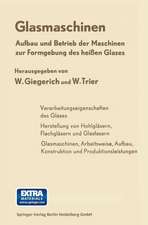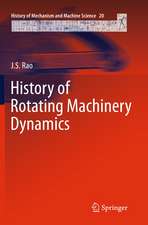Kinematics of Machinery Through HyperWorks: History of Mechanism and Machine Science, cartea 18
Autor J. S. Raoen Limba Engleză Hardback – 5 apr 2011
displacements, velocities and accelerations forms the subject of kinematics.The study of forces that make the motion is the subject of kinetics; combining these two subjects leads to dynamics of machinery. When we include the machinery aspects such as links, kinematic chains, and mechanisms to form a given machine we have the subject of Theory of Machines.
Usually this subject is introduced as a two-semester course, where kinematics and kinetics are taught simultaneously with
thermodynamics or heat engines before progressing to the design of machine members. This book provides the material for first semester of a Theory of Machines- course.
Th is book brings in the machine live onto the screen and explains the theory of machines concepts through animations and introduces how the problems are solved in industry to present a complete history in the shortest possible time rather than using graphical (or analytical) methods. Thus the students are introduced to the concepts through visual means which brings industrial applications by the end of the two semester program closer, and equips them better for design courses.
The International Federation for promotion of Mechanism and Machine Science (IFToMM) has developed standard
nomenclature and notation on Mechanism and Machine Science and this book adopts these standards so that any communication between scientists and in the classrooms across the world can make use of the same terminology. This book adopts HyperWorks MotionSolve to perform the analysis and visualizations, though the book can be used independent of the requirement of any particular software. However, having this software helps in further studies and analysis. The avis can beseen by entering the ISBN of this book at the Springer Extras website at extras.springer.com
| Toate formatele și edițiile | Preț | Express |
|---|---|---|
| Paperback (1) | 559.68 lei 39-44 zile | |
| SPRINGER NETHERLANDS – 30 apr 2017 | 559.68 lei 39-44 zile | |
| Hardback (1) | 647.40 lei 3-5 săpt. | |
| SPRINGER NETHERLANDS – 5 apr 2011 | 647.40 lei 3-5 săpt. |
Din seria History of Mechanism and Machine Science
- 15%
 Preț: 666.73 lei
Preț: 666.73 lei - 18%
 Preț: 1018.55 lei
Preț: 1018.55 lei - 20%
 Preț: 752.94 lei
Preț: 752.94 lei - 18%
 Preț: 1002.61 lei
Preț: 1002.61 lei - 18%
 Preț: 950.52 lei
Preț: 950.52 lei - 18%
 Preț: 735.84 lei
Preț: 735.84 lei - 15%
 Preț: 649.54 lei
Preț: 649.54 lei - 15%
 Preț: 637.46 lei
Preț: 637.46 lei - 18%
 Preț: 1227.67 lei
Preț: 1227.67 lei - 15%
 Preț: 633.35 lei
Preț: 633.35 lei -
 Preț: 384.31 lei
Preț: 384.31 lei - 15%
 Preț: 655.92 lei
Preț: 655.92 lei -
 Preț: 389.70 lei
Preț: 389.70 lei - 15%
 Preț: 644.82 lei
Preț: 644.82 lei - 18%
 Preț: 954.45 lei
Preț: 954.45 lei -
 Preț: 442.13 lei
Preț: 442.13 lei - 20%
 Preț: 576.88 lei
Preț: 576.88 lei - 18%
 Preț: 944.19 lei
Preț: 944.19 lei - 24%
 Preț: 788.01 lei
Preț: 788.01 lei - 15%
 Preț: 647.73 lei
Preț: 647.73 lei - 15%
 Preț: 645.28 lei
Preț: 645.28 lei - 18%
 Preț: 963.60 lei
Preț: 963.60 lei - 18%
 Preț: 967.08 lei
Preț: 967.08 lei - 15%
 Preț: 645.28 lei
Preț: 645.28 lei -
 Preț: 399.29 lei
Preț: 399.29 lei - 15%
 Preț: 644.82 lei
Preț: 644.82 lei - 20%
 Preț: 594.05 lei
Preț: 594.05 lei - 15%
 Preț: 645.28 lei
Preț: 645.28 lei
Preț: 647.40 lei
Preț vechi: 761.65 lei
-15% Nou
Puncte Express: 971
Preț estimativ în valută:
123.88€ • 132.47$ • 103.29£
123.88€ • 132.47$ • 103.29£
Carte disponibilă
Livrare economică 27 martie-10 aprilie
Preluare comenzi: 021 569.72.76
Specificații
ISBN-13: 9789400711556
ISBN-10: 9400711557
Pagini: 300
Ilustrații: XII, 282 p. With online files/update.
Dimensiuni: 155 x 235 x 18 mm
Greutate: 0.61 kg
Ediția:2011
Editura: SPRINGER NETHERLANDS
Colecția Springer
Seria History of Mechanism and Machine Science
Locul publicării:Dordrecht, Netherlands
ISBN-10: 9400711557
Pagini: 300
Ilustrații: XII, 282 p. With online files/update.
Dimensiuni: 155 x 235 x 18 mm
Greutate: 0.61 kg
Ediția:2011
Editura: SPRINGER NETHERLANDS
Colecția Springer
Seria History of Mechanism and Machine Science
Locul publicării:Dordrecht, Netherlands
Public țintă
ResearchCuprins
1. Beginnings of Theory of Machines; 1.1 Beginning of the Wheel; 1.2 Archimedes (287-212 BC); 1.3 Water Wheels; 1.4 Wind Mills; 1.5 Renaissance Engineers; 1.6 Industrial Revolution; 1.7 How is this book organized?; 2. Planar Mechanisms; 2.1 Basic Kinematic Concepts; 2.2 Elementary Mechanisms; 2.3 Grübler’s Criterion for Planar Mechanisms; 2.4 Four Link Chains; 2.5 Kinematic Inversion; 2.6 Additional Problems; 3. Kinematic Analysis of Mechanisms; 3.1 Velocities by Centro Method; 3.2 Relative Velocity Equation; 3.3 Relative Acceleration Equation; 3.4 Acceleration Analysis of Reciprocating Engine Mechanism; 3.5 Analytical Determination of Velocity and Acceleration of the Piston; 3.6 Additional Problems; 4. Straight Line Motion and Universal Coupling; 4.1 Condition for Exact Straight Line Motion; 4.2 Exact Straight Line Motion Mechanisms; 4.3 Approximate Straight Line Motion Mechanisms; 4.4 Steering Gear Mechanism; 4.5 Hooke’s (Cardan, Universal) Joint [Universal Coupling]; 4.6 Solved Problems; 4.7 Additional Problems; 5. Cams; 5.1 Types of Cams and Followers; 5.2 Displacement Diagrams; 5.3 Disk Cam with Knife-Edge Follower; 5.4 Translating Roller Follower; 5.5 Translating Flat Follower; 5.6 Oscillating Flat Follower; 5.7 Cams of Specified Contour; 5.8 Solved Problems; 5.9 Additional Problems; 6. Gears; 6.1 Classification of Gears; 6.2 Types of Motion; 6.3 Nomenclature; 6.4 Law of Gear Tooth Action; 6.5 Involute as a Gear Tooth Profile; 6.6 Layout of an Involute Gear Set; 6.7 Producing Gear Teeth; 6.8 Meshing Gears and Line of Contact; 6.9 Interference of Involute Gears; 6.10 Minimum Number of Teeth to Avoid Interference; 6.11 Contact Ratio; 6.12 Cycloidal Tooth Profiles; 6.13 Cycloidal and Involute Tooth Forms; 6.14 Solved Problems; 6.15 Additional Problems; 7 Helical, Spiral, Worm and Bevel Gears; 7.1 Involute Helicoid; 7.2 Helical Gear Tooth Relations; 7.3 Contact of Helical Gear Teeth;7.4 Helical Gear Calculations; 7.5 Spiral [Crossed Helical] Gears; 7.6 Worm Gearing; 7.7 Bevel Gears; 7.8 Formation of Bevel Gears; 7.9 Solved Problems; 7.10 Additional Problems; 8 Gear Trains; 8.1 Classification of Gear Trains; 8.2 Simple Gear Trains; 8.3 Compound Gear Trains; 8.4 Synthesis of Gear Trains; 8.5 Gear Train Applications to Machine Tools; 8.6 Epicyclic Trains; 8.7 Inversions of Epicyclic Trains; 8.8 Differential Trains; 8.9 Torque Distribution in Epicyclic Trains; 8.10 Example of an Epicyclic Train; 8.11 Coupled Epicyclic Trains; 8.12 Wilson Four Speed Automobile Gear Box; 8.13 Solved Problems; 8.14 Additional Problems; Index.
Textul de pe ultima copertă
The concept of moving machine members during a thermodynamic cycle and the variation of
displacements, velocities and accelerations forms the subject of kinematics.The study of forces that make the motion is the subject of kinetics; combining these two subjects leads to dynamics of machinery. When we include the machinery aspects such as links, kinematic chains, and mechanisms to form a given machine we have the subject of Theory of Machines.
Usually this subject is introduced as a two-semester course, where kinematics and kinetics are taught simultaneously with
thermodynamics or heat engines before progressing to the design of machine members. This book provides the material for first semester of a Theory of Machines- course.
Th is book brings in the machine live onto the screen and explains the theory of machines concepts through animations and introduces how the problems are solved in industry to present a complete history in the shortest possible time rather than using graphical (or analytical) methods. Thus the students are introduced to the concepts through visual means which brings industrial applications by the end of the two semester program closer, and equips them better for design courses.
The International Federation for promotion of Mechanism and Machine Science (IFToMM) has developed standard
nomenclature and notation on Mechanism and Machine Science and this book adopts these standards so that any communication between scientists and in the classrooms across the world can make use of the same terminology. This book adopts HyperWorks MotionSolve to perform the analysis and visualizations, though the book can be used independent of the requirement of any particular software. However, having this software helps in further studies and analysis. The avis can beseen by entering the ISBN of this book at the Springer Extras website at extras.springer.com
displacements, velocities and accelerations forms the subject of kinematics.The study of forces that make the motion is the subject of kinetics; combining these two subjects leads to dynamics of machinery. When we include the machinery aspects such as links, kinematic chains, and mechanisms to form a given machine we have the subject of Theory of Machines.
Usually this subject is introduced as a two-semester course, where kinematics and kinetics are taught simultaneously with
thermodynamics or heat engines before progressing to the design of machine members. This book provides the material for first semester of a Theory of Machines- course.
Th is book brings in the machine live onto the screen and explains the theory of machines concepts through animations and introduces how the problems are solved in industry to present a complete history in the shortest possible time rather than using graphical (or analytical) methods. Thus the students are introduced to the concepts through visual means which brings industrial applications by the end of the two semester program closer, and equips them better for design courses.
The International Federation for promotion of Mechanism and Machine Science (IFToMM) has developed standard
nomenclature and notation on Mechanism and Machine Science and this book adopts these standards so that any communication between scientists and in the classrooms across the world can make use of the same terminology. This book adopts HyperWorks MotionSolve to perform the analysis and visualizations, though the book can be used independent of the requirement of any particular software. However, having this software helps in further studies and analysis. The avis can beseen by entering the ISBN of this book at the Springer Extras website at extras.springer.com
Caracteristici
Subject matter is explained through animations; Explains the evolution of Kinematics; Illustrates progress and developments in Kinematics. Includes supplementary material: sn.pub/extras



















